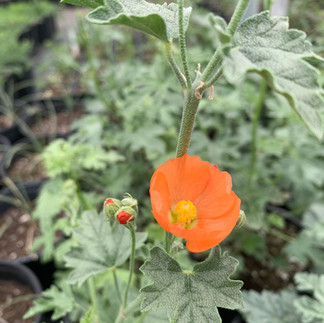Featured Plant: Munro’s Globemallow - Sphaeralcea munroana
- Christine Lawson

- May 30, 2021
- 2 min read
(Photos provided by Great Bear Native Plants, Map provided by USDA-NRCS)
Munro’s globemallow (Sphaeralcea munroana) is a gem of arid west ecosystems. This bright and cheerful forb grows naturally in dry habitats in the western U.S. and British Columbia. Typically, in natural settings munro’s globemallow is found in association with sagebrush-dominated habitats from the desert plains to low mountain slopes. This species’ success growing in harsh, disturbed and dry conditions makes it a valuable restoration species for arid regions. Munro’s globemallow showy flowers and low maintenance requirements also make it a sought after component of waterwise gardens and landscaping.
Munro’s globemallow is a native perennial forb or subshrub that grows in an open branching form up to 32 inches tall. Leaves and stems are a delicate pale green color and, due to a covering of fine white hairs, have a slightly rough texture. These leaf hairs help ward off long and strong sun exposure and block wind movement at the leaf level which can lessen the plant’s daily water loss. Munro’s globemallow plants have bright orange-red flowers borne in showy clusters that bloom from May through August. Seeds are produced in dry fruits with multiple capsules that form a sphere, hence the name “globemallow”. The genus name Sphaeralcea is from the Greek word “spharia” which means globe and the Latin word “alcea” which means a kind of mallow.
This species makes a great addition to xeric landscaping in the western U.S. and is appropriate for USDA hardiness zones 4 to 9.Munro’s globemallow can bring a shock of bright orange color to summer gardens. Along with stunning blooms, globemallow is easy to grow and requires relatively little maintenance. Globemallow attracts a variety of good pollinator species including ground dwelling native bees. The species is also both reported to be deer and rabbit resistant. Use globemallow to bring a splash of color to rock gardens or in tight spaces like along walkways and driveways.
Planting Notes
Plant Munro’s globemallow in well-drained rocky, sandy soils. The species also does well in heavy clay soils.
Munro’s globemallow prefers full sun exposure, so plant in sunny locations.
This species is adapted to dry environments. In its native range, Munro’s globemallow only requires from 6 to 15 inches of precipitation annually to establish and survive. Be sure to water newly planted globemallow plants regularly in its first year of establishment. In subsequent years, you can deeply water globemallow occasionally during the heat of summer.
Deadheading does not extend bloom time for this species, but can prevent any new unwanted seedlings.
For an attractive regrowth, cut plants to the ground level in mid-spring.
Planting Buddies
For folks looking to create waterwise gardens consider planting Munro’s globemallow with these other species:
Sagebrush species (Artemisia species)
Rabbitbrush (Chrysothamnus species)
Juniper (Juniperus species)
Blue grama (Bouteloua gracilis)
Indian ricegrass (Achnatherum hymenoides)
Common yarrow (Achillea millefolium)
Cutleaf daisy (Erigeron compositus)
Wild blue flax (Linum lewisii)
Blanket flower (Gaillardia aristata)
Beardtongue (Penstemon species)
Sources:
Ladybird Johnson Wildflower Center plant profile:
https://www.wildflower.org/plants/result.php?id_plant=spmu2
USDA NRCS Plant Guide: https://plants.usda.gov/DocumentLibrary/plantguide/pdf/pg_spmu2.pdf
USDA NRCS Plant Profile: https://plants.usda.gov/home/plantProfile?symbol=SPMU2
Western Forbs: biology, Ecology and uses in restoration - Munro’s Globemallow:










Comments